
Golf History
According to a historian at the United States Golf Association, it is widely accepted that modern golf has its foundations in Scotland. The real origin of golf is still under debate by many historians. Early stick and ball games can be traced back to as far as the 13th century not only in Europe but in Asia and parts of Africa as well.
The word “golf” may have originated from the Dutch “kolf” or “kolv” meaning “to club.” It became “gouff” or “goff” in the Scottish dialect. The connection may be attributed to the active trade between the Dutch and Scottish ports from the 14th to the 17th centuries. The word “golf” as we know it appeared around the late 16th century.
The first recorded writing on instructions on how to play the game also appeared in the 16th century in Dutch and Latin texts. The townspeople in Scotland would play friendly and informal games in public lands. In the 18th century, the Scottish monarch banned the games because the king felt it distracted citizens from military practice, including archery.
It is widely believed that golf’s popularity rose during the Industrial Revolution in Europe when trains enabled English tourists to go on golf trips to Scotland.
In the US, the game became known in upstate New York between 1650 and 1660. It rose to fame around 1770 in British and Scottish communities that had golf clubs in New York, the Carolinas, Charleston, Georgia, Pinehurst, and Savannah. Its popularity waned around the time of the War in 1812 but came back in the 1880s.





Golf Etiquette
Here are some basic golf etiquette tips.
Some golf courses are stricter than others when it comes to the dress code. If you’re not sure, call ahead of time. There’s nothing worse than arriving at the golf course and not being allowed to play. For men, a collared shirt with knee-length shorts or golf pants is the standard. For women, the typical golf attire includes a collared shirt, pants, skirt, shorts, or skort that are not too short.
Most golf courses don’t allow golf shoes with metal spikes because of the damage they can cause to the greens and the flooring in the clubhouse. You may also wear a hat, shades, and gloves. Driving ranges might be less strict on the dress code.
Arrive ahead of schedule, so you still have time to practice, use the restroom, prepare your bag and clubs.
Typically, playing a round of 18 holes will probably take around four hours. You should constantly move to the next hole. Avoid holding up the group behind you because they will find it annoying. It’s a good indicator if you can keep up with the group in front of you.
Be as quiet as possible when someone is setting up their ball or taking a shot. Avoid talking with other players or rummaging through your bags when someone is taking a shot. Playing loud music and yelling are not allowed, except when someone has to say, “Fore!”
If someone hits their shot, you can compliment them on a great shot. If it was a poor shot, there’s no need to criticize or say anything negative.
Golf balls are robust and could hurt on impact. Hitting someone is both disrespectful and dangerous. If you hear someone yell, “Fore” stoop and cover your head. It means a ball is coming towards you. If you are playing and accidentally hit a ball towards a group of people, you have to yell to warn them.
The person farthest away from the pin or the hole gets to hit first for safety reasons. No one should be standing in front of someone hitting their ball.
Generally, it’s a bad idea to stand too close to someone about to hit their ball or near people practicing their swing. Also, avoid standing in someone’s line of sight.
Use a ball marker to mark where your ball lands on the green. Other players might find it distracting if you leave your ball or it could be in someone’s line of sight.
If you take a divot or leave marks, try to fix it as best as possible. This will ensure there won’t be any brown welts on the greens.
Always follow the signs. Drive carefully. Try not to tear up the course. If someone is taking their shot, don’t try to drive up in front of them.
Think about where your next hole is and park on that side. You don’t have to cross back to your cart after taking a shot. Also, try not to park your cart too close to other people’s line of sight.
Mark your ball with a permanent marker, or choose one in a color that’s easy for you to identify. Once you hit your ball, watch where it lands so you’ll know where to go for your next shot. If you lose a ball, try not to spend more than three minutes looking for it. If someone else loses their ball, you can help them find it.
Be honest when marking your scorecard since you’re responsible for remembering the number of shots you hit on a hole. You can also use phone apps if you find it easier to do so.
Even if you’re having a bad day, don’t swear and lose your temper on the fairway. Be a good sport if you lose, and stay humble if you win. Shaking hands after a game are good. Reward yourself at the bar or restaurant after a game.










Golf Rules
Ten essential rules for beginners.
- You can carry as many as 14 clubs in your bag during the competition.
- Tee up within the correct parameters.
- Don’t mistake another player’s ball for your own or risk getting a penalty.
- When you reach the greens, mark your ball in the exact spot.
- Always play wherever your ball comes to rest.
- You have three options if your ball comes to rest in a spot where you think it’s not playable. Refer to Rule 19 in the rule book for the complete ruling.
- Know what to do if your ball goes out of bounds.
- You can only ask for advice from your teammate, never your opponent. Do not offer any advice either, but you may ask about the rules.
- Understand the definition of ball striking.
- Make sure to complete your scorecard correctly. Both parties sign the card as a correct record of each hole.
When in doubt, always refer to the complete rule book.







Golf Apps
Nowadays, there are apps for almost anything including golf. Here are some things you might find useful in an app, or if you don’t use them yet, these are the features you should look for.
- GPS or course management
- Swing analysis for game improvement
- Golf fitness
- Tee times
- Golf social to help you find someone to play with if you’re in a new place
- Online golf games
- Weather
If you’re serious about golf, USGA Rules of Golf is an essential app to have.












Golf Apparel
- Collared shirts; no T-shirts
- Golf pants, slacks with belt loops; no jeans
- Shorts just above the knees; not too long nor too short
- Ankle or tube socks to match
- Golf shoes; no metal spikes
Clothing should always be modest.
- Collared shirt; no tube tops
- Golf pants, slacks, shorts, skirts, shorts
- Dress
- Ankle or tube socks to match
- Golf shoes; no metal spikes
- Hats
- Sunglasses
- Gloves







Golf Balls
Most golf balls have 250 to 500 dimples. The dimples create lift while also reducing the drag. A golf ball with dimples can travel twice as far as a smooth one.
- One-piece balls are typically used on driving ranges or crazy courses. As the name suggests, the ball is made with only one kind of material, Surlyn, which is very tough and durable. One-piece balls tend to be heavy and have a very low spin. They are also inexpensive.
- Two-piece balls feature a solid core coated in Surlyn or softer urethane. It has a firm feel and is great for distance and durability. This ball is great for beginners.
- Three-piece balls have a solid rubber core, enclosed by a layer of enhanced liquid rubber, and then wrapped in a soft, synthetic plastic cover. The three layers give the ball a softer feel and produce more spin making it easier to control around the greens. They are a popular choice among serious players and are used by some of the best players in the world at the PGA Tour and the European Tour. They also don’t come cheap so they aren’t the best for beginners and less competent golfers.
- Four-piece balls have a softcore wrapped in two separate layers. The thin urethane cover gives it a soft feel. The idea is complex, but in theory, there would be a “spin separation” where the driver shots would spin less while the short irons spin more. However, this concept is still widely debated and it’s uncertain if anyone will notice the difference, except for the very best and experienced players.
- Five-piece balls are built with five layers designed to optimize performance in five key areas, namely: driving, long irons, mid irons, short irons, and short wedge shots. The goal is to increase distance and control from tee to green with a ball that lowers the score. The difference between using the traditional three-piece balls and the four-piece or five-piece boils down to the preference of the player.
Compression refers to how much the golf ball squashes when it is struck by the club. The more compression there is, the ball travels farther as it rebounds off the club. Most balls have a compression range between 40 to 100.
Beginners or high handicap players would benefit more from low-compression balls as they are softer and compress easier. This helps create more distance even with a low-swing speed. Better or more experienced players prefer high-compression balls to achieve distance and gain better control even with a fast-swing speed.
How a golf ball feels depends on its construction. Two-piece balls with a rubber core feel hard, are durable, and produce greater distance. Three, four, or five-piece balls with a soft rubber core and soft urethane cover feel soft, will not be as durable, but will have more control and more spin.
Golf balls are also designed with the backspin in mind. Low-spin balls tend to fly straight through the air and roll further when it lands. They’re great for golfers who struggle with distance. High-spin balls have a longer carry, meaning they spin the most through the air.
They’re not great for distances, but they make up for it with added control and feel once in the greens. Mid-spin balls try to mix the best from low and high-spin balls. They’re suitable for use by a wide range of golfers and are good in any condition.
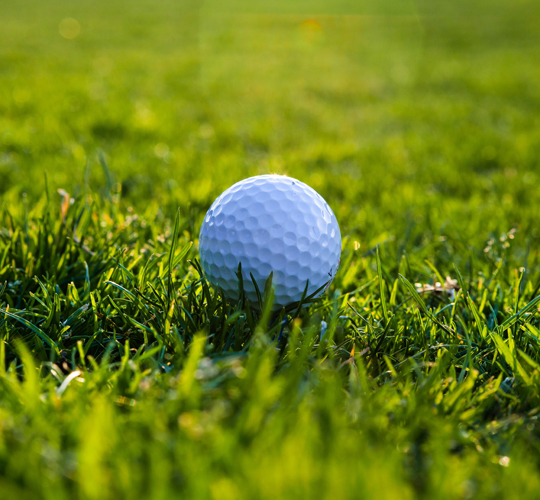

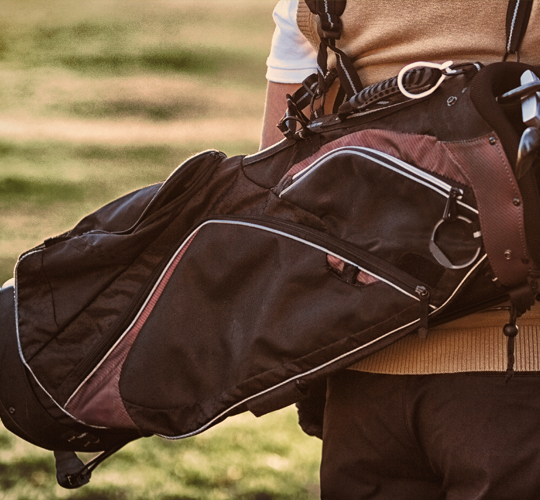









Golf Bags
They are the lightest and easiest to transport on and off the course. They carry the bare essentials and are easy to fold when not in use. The shoulder straps make them easy to carry around. They are designed for beginners, casual players, or anyone who prefers to walk the golf course.
Sunday bags, as they are called sometimes, got the name decades ago when caddies were not allowed to work on Sundays. The enthusiastic players who still chose to play carried their bags with just the essentials. Hence, the nickname was born.
These bags are probably the most versatile type of golf bag. They are made of lightweight material but are still heavier than the standard carry bag. They have a built-in mechanism, legs, which keep the bag in an upright position.
The bags are designed to be carried like a backpack so that the weight is distributed better across the golfer’s body much better than the traditional single-strap. They can be used while walking on the golf course or loaded into a golf cart.
These bags are designed with bases made to attach to a golf cart. These are heavy, full-sized bags that have plenty of storage for all your things. They are not designed for carrying on the course. Usually, there would be a single strap on these bags to tie them down securely on the cart. They are designed for competitive, serious, and professional players.
Tour bags have the greatest number of dividers, pockets, and storage. They are bulky and heavy, often weighing more than a cart or a stand bag. They do offer some protection for the clubs. Generally, golfers who don’t carry their bags use these. For professional players, these are great for advertising the brands that sponsor them.
As the name suggests, these bags are made for traveling with your golf clubs. Usually made of a hard case, these would cover your entire bag and keep them safe during flights or baggage handling. Golfers who travel to play should have these bags.
Now that you know what types of golf bags are there. What are the defining features you should look for in a bag?
- Some bags have no dividers at all, while others will have anywhere between two to 14 dividers that are meant to keep your clubs from rattling around and hitting each other.
- You’re going to want a lot of pockets, some with zippers, others just openings. Look for a bag that has lined pockets for your valuables, a waterproof pocket for your rangefinder and scorecard, and maybe an insulated pocket to keep your drink cold.
- Pay attention to the stand and straps of the bag you choose. Some designs are for attaching the bag to a cart and others are for securing them in push or pull carts.
- Your bag should look and feel durable. Look for bags that use double-stitching.
Check the bag manufacturer’s defective policies. Ask what kind of warranty is covered, if they will repair or replace a bag if it breaks, and if there are replacement parts.







Golf Clubs
Woods refer to the category of golf clubs including the driver and fairway woods. They are still called that way even if they’re not made of wood anymore. They are the ones with the largest heads and a flat front where you hit the golf ball. They also have the longest shafts. They are used at the beginning when the golfers tee off or for long-range shots.
Also referred to as “blades”, irons have smaller heads compared to woods and they have an extreme angle to them. Some have solid heads, while some are hollow. They have angled faces called “lofts” that have grooves in them and help grip the ball while imparting spin.
They are usually numbered from 3 to 9; the loft increases with the number while the length of the shaft decreases. They are used after tee-off.
Putters have short shafts and smaller clubheads and are used for “putting.” They are the most specialized clubs and come in many different shapes and sizes. They are used for the last strokes on the putting greens to knock the golf ball into the hole.
Wedges refer to clubs including the pitching wedge, gap wedge, sand wedge, and lob wedge. They can also be considered a sub-set of irons because, in essence, they have the same club heads but with more angles for the loft. They are the highest-lofted clubs and are used for shorter approach shots and for getting out of sand bunkers.
Hybrids have been around for many years but only became mainstream around the 21st century, making them the newest category in golf clubs. They are called as such because the clubhead looks like a cross between a wood and an iron. Like irons, they are also numbered and are also considered iron-replacement clubs.


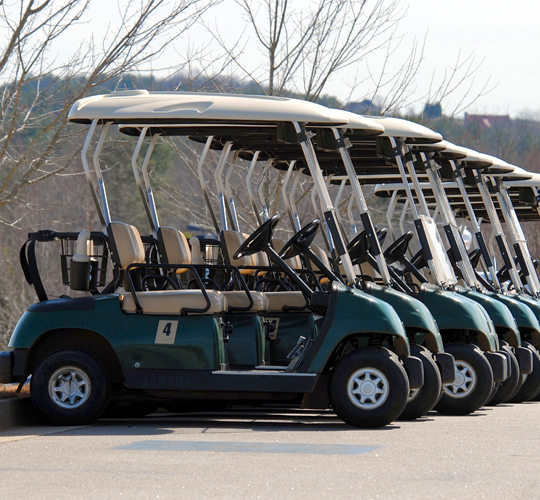









Golf Carts
Golf carts used to be for elderly players only, but now players of all ages can benefit from using them.
- Golf push carts are probably the most popular among golf carts and the best among manual ones. From the name, it is pushed and doesn’t have a motor. They come in three or four-wheeled varieties. They are easy to control, are lighter compared to electric models, and have more space.
- Golf pull carts are the smallest, lightest, and simplest types among the golf carts. They only have two wheels and are probably the cheapest kind. However, they can be difficult to pull at times and would probably put a strain on your shoulders. Because they’re small, they don’t have a lot of storage space.
- Electric golf carts run on rechargeable batteries and produce no emissions, making them environment-friendly. They’re also user-friendly and make very little noise when using them. Older models used to be for one passenger only, but now you can find them in two or three-passenger models. Because they run on batteries, it’s a little difficult to estimate the longevity of their power after charging and you can only charge them in charging stations.
- Remote-controlled golf carts look like push or pull carts except they’re powered by a battery and remote control. You can move them anywhere you want to. They have a strong battery and a console to indicate battery life, distance covered, and others. They tend to be on the expensive side including their maintenance.
- Gas-powered golf carts operate similarly to a regular car. Because they use gas, they aren’t the environment-friendly option. They can cover great distances and are great for bigger courses, but they tend to be noisy and may distract other golfers.
Luxury golf carts are no ordinary golf carts. They look very good and are very comfortable to ride on. You can customize them with the luxury features that you want. They come with a hefty price tag though including parts and maintenance.







Golf Courses
- A links course is probably the most famous type of golf course there is. Its name is derived from an old English word “hlinc”, which means ridge or rising ground. It also refers to sandy areas along the coast. While many courses will claim they are links or link-style, you have to meet specific characteristics to be considered a true link course. They have to be in a coastal location with sandy soil, which drains very well and stays firm making it perfect as a golf course. A link course will have natural ridges, hills, and fairways. Its openness can be a challenge to golfers especially if there’s a lot of wind. True links courses can be found in England, Ireland, and Scotland where modern golf also originated, as well as in many other parts of the world.
- A parkland course, in contrast, is built inland and away from the coast. They’re called parklands because it looks like you’re playing in a park; there would be lots of trees and lush, well-manicured grass. It might not be as challenging as playing on a links course so it would be up to the course architect to add features to attract golfers.
- A desert course is built in an area with, you guessed it, a desert. The golf course is built around dunes and other natural features of a desert. Because it’s so unnatural for the area, you would only find grass in the tee box, fairways, and in the putting greens. These golf courses are common in the American southwest and the Middle East.
- Executive courses are designed for quick play. A course can have nine or 18-holes, the latter usually not higher than a par-65. The course focuses on holes that can be finished within a shorter time frame. It was designed for, and probably named after, executives who play in between their office breaks or on their way home from work.
- Regulation courses are 18-hole with a higher par than executive courses. Some of them may be called championship courses even if they haven’t hosted an actual championship tournament.


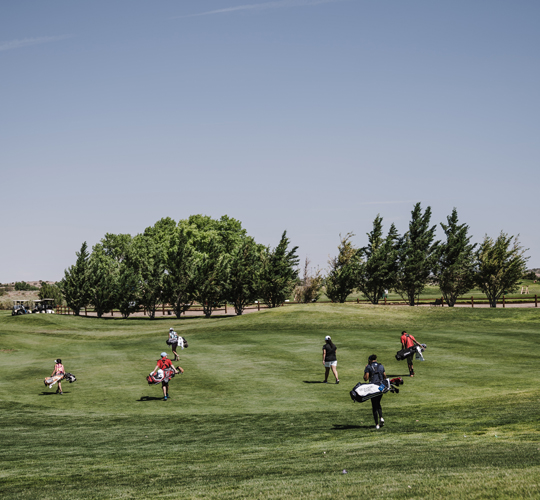









Course Access
- Municipal courses are golf courses that are owned either by the city or municipality. You pay a fee every time you use their facilities. Some of them offer the lowest fees but those may differ if you are a resident or non-resident.
- Daily-fee courses are open to the public, but unlike municipal courses, they are usually owned and operated by private corporations.
- Semi-private courses may offer players the option of paying for a membership fee or just paying each time they play. You may enjoy more perks by being a member instead of paying per visit. A resort course is a somewhat similar setup where guests or members have access to the course, while non-members can also pay to play. Compared to a private course, a semi-private one may not have as many amenities.
- Private courses – Club owners own private courses. One needs to be a member of the club to play. Members typically pay initiation and annual fees. Country clubs often have additional perks for their members including bars, dining rooms, and social halls in their clubhouses. Country clubs do not offer access to members of the public.







Golf Scoring
There are many terms you have to remember when playing golf. Some of these include terminology for scoring. Here are the most common scoring terms you should know.
Par refers to the number of strokes it takes an experienced golfer to play a hole. The par of each hole is posted on a sign on the tee box and marked on the scorecard. A standard 18-hole golf course has par-72 in total, though you might find a par-70 or par-71.
Birdie refers to the score a golfer makes if he finishes a hole with 1 under par. For example, if a golfer scores 3 on a par-4 hole, he scored a birdie. It’s a significant achievement for a golfer and helps a player put a lead or gain ground on whoever is leading.
Eagle refers to the score of 2 under par. If a golfer scores an eagle on a par-3, it means he also scored a hole-in-one.
Hole-in-One is a big achievement for a newbie or amateur golfers. It refers to a shot that ends up on the hole straight from the tee. It’s a common occurrence on a par-3 hole because the greens are easy to reach from the tee box. A hole-in-one is also called an “ace.”
Albatross also called a “double-eagle” is scored 3 below par. It might even be rarer than an ace.
Bogey is a score of 1 over par. A double-bogey is 2 over par.
There are different types of scoring methods and they can be categorized into individual and team play.
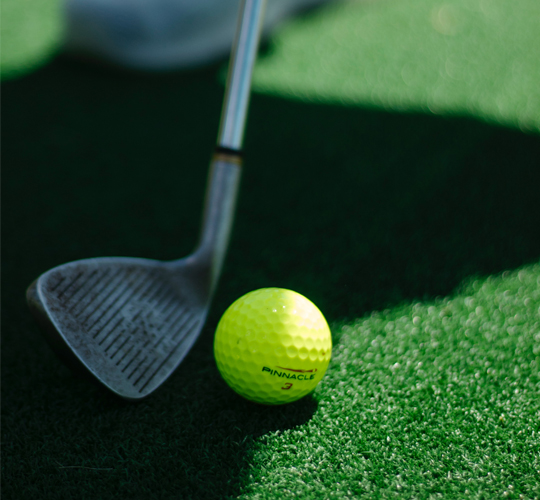

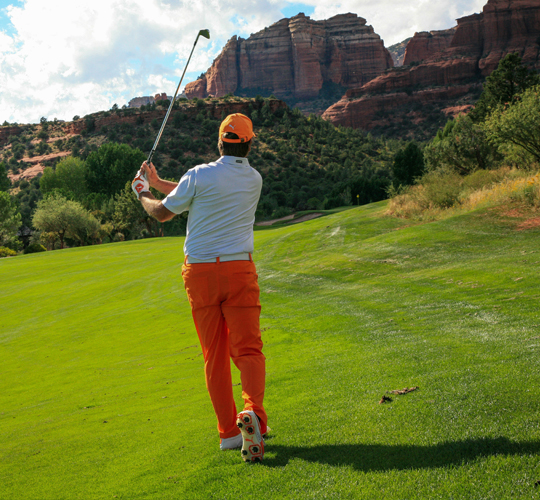









Individual Scoring
Playing golf isn’t like playing other sports. In golf, the player with the lowest score wins. When playing a game using stroke play, the goal is to finish each hole on the course with the fewest possible strokes. The golfer with the fewest strokes over the round of the course wins.
Most professional tournaments use this scoring system with a few exceptions and tournaments with team events.
Like stroke play, scoring in match play accounts for the number of strokes for each hole, except a winner is determined for each hole by comparing the number of strokes for each opponent. The golfer with the fewest strokes per hole wins that hole. The golfer who won the most holes by the end of the course wins. The Ryder Cup and Presidents Cup use a match play format.
Unlike the previous two scoring systems, Stableford is more traditional in that the player with the highest score at the end of the game wins. Dr. Frank Barney Gorton Stableford is credited with creating the scoring system in the late 1800s. He found that most golfers felt discouraged and tend to give up quickly after a bad start so he found a way to keep the game going and make it fun along the way.
Using this system, players are given points for each hole. The number of points each golfer receives is based on the number of strokes taken to finish the hole. The points are also adjusted depending on the golfer’s handicap.
Depending on the group of players, a modified Stableford can be used to make the game harder or easier. It is used by the PGA Tour for the Barracuda Championship because the players are so good.
The Stableford play is also a fun way to mix up the game if you’re playing with your friends though it seems to be more popular in the UK than it is in the US. Using a golf app makes it easier to track the scores when using this play.







Team scoring
A foursome is a pair-playing format. It can also be called “alternate shots.” Using only one ball, golfers in each team take turns with every shot until the hole is finished. The players take turns to tee off on each hole so one golfer takes the holes with the odd numbers and the other one takes the holes with the even numbers.
Foursomes can be scored either as a match play or stroke play. The team that finishes each hole with the fewest strokes wins that hole. The Ryder Cup, Presidents Cup, Seve Trophy, and Solheim Cup use this play format.
In competitions using stroke play, the team that takes the fewest number of strokes to finish a set number of holes wins. The World Cup of Golf uses this format, alternating it with rounds of four-ball, since 2000. The Zurich Classic also uses the same format and alternating rounds on the PGA Tour since 2017.
Four-ball is sometimes called “better ball” or “best ball”, and then abbreviated as “4BBB.” It is another type of pair-playing format in golf.
In 4BBB, the two teams tee off together, which means four balls are in play on each hole within the group. The low score, the better score, between partners count as the score of the team.
Greensomes follow almost the same arrangement as Foursomes. The difference is that both players tee off on every hole then choose the better ball. From there, they take alternate shots to finish the hole. Bass Pro Shops Legends of Golf uses this format.
Bloodsomes are almost the same as Greensomes. All golfers (two from each team) get to tee off but the opposing team gets to pick which ball they want their opponent to play next. As a result, golfers will often play from the worst drives rather than the best ones. They will still alternate each stroke until they reach the end of the hole.
Each player in a team of four tees off. They choose the best shot out of the four and mark the location of the ball. All four team members take their next shot from the same marker. Again, they choose the best shot until they are holed out.
Choosing the best shot out of four each time results in much lower scores. Scores are given in Scramble using stroke play.
Texas Scramble applies the same rules as Scramble with a requirement added for good measure. The team takes at least four tee shots from each member. This takes care of the issue of always choosing the better tee shot over the other tee shots.
Some team games use a Shotgun Start with each team starting on a separate hole. As the name suggests, the shotgun is fired to signal the beginning of the competition. Because all the holes are played simultaneously, the time for the whole competition is significantly reduced as well.


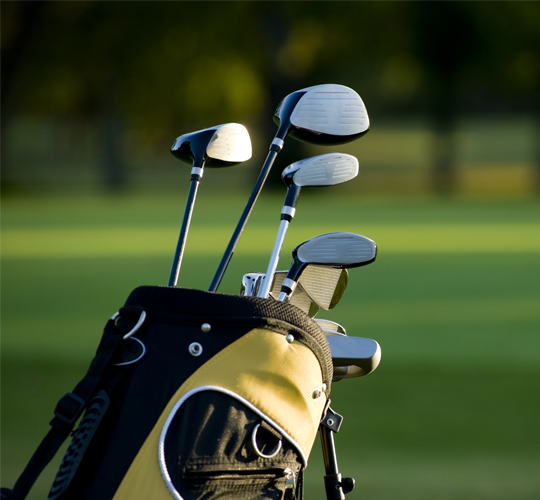









Golf Terms
You need to familiarize yourself with golf terminologies when you’re starting. Below are the most important words you would often hear on the course.
Albatross is the score a golfer gets for completing a hole three strokes under par. Sometimes it is also called a “double eagle.” This is a very rare score to get.
A hole played one stroke better than the projected standard is called a birdie.
A golfer who gets one stroke over par for a hole scores a bogey. Two over par is a double-bogey and so on. It is not unusual to score a bogey five.
A drive is a long tee shot played using a driver or a wood.
A bad shot is called duff.
Eagle is what a golfer gets if he completes a hole in two strokes under par.
Fairway refers to the short grass between the tee and the putting green. This is where golfers aim for.
The marker of holes on the course is called flags.
Golfers should yell “FORE!” to warn other golfers or spectators that a ball is heading in their direction.
Green refers to the specially arranged grass surface surrounding the hole, where golfers attempt to putt the ball.
A handicap refers to the average number of strokes above par that a player scores in around.
A golfer gets a hole-in-one when he hits the ball into the hole directly from the tee shot. Also called an “ace”, this is a rare shot but not an impossible one to make.
Irons refer to the numbered clubs numbered from one to nine.
The professional average result is abbreviated as par, which refers to the typical score for a hole or an entire course. It states the number of shots a professional is anticipated to take to finish the round.
Putt is the shot played on the green, using a putter to get the ball into the hole.
A putter is a flat-edged golf club used so the ball runs effortlessly from the green into the hole.
The grass on either side of the fairway is called rough and it is best to avoid them.
Paying around means playing on the course, which usually consists of 18 holes.
A sand bunker is a concave area, which is considered a hazard. It is also called a “beach.”
A severely angled club used to get out of a beach is called a sand wedge.
The sweet spot is a part of your club that you want to hit the ball with, to direct it where you want it to go.
Golfers start each hole on the tee. It may also refer to the wooden or plastic peg that you place on the ground where you place your ball when you tee off.
You use a woods club to hit the ball the farthest. In the old days, the heads of the clubs used to be made from wood, hence the name. Typically, woods are used to tee off.

